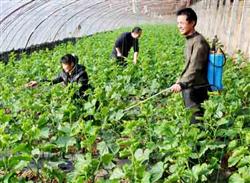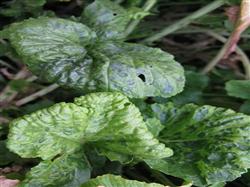Radish planting video picture: Baiyuchun radish cultivation

Bai Yuchun is a radish variety produced by South Korea bio Co., Ltd., which was introduced by Beijing Shinong Seedling Co., Ltd. The plant type and quality of this variety are different from Bai Yuchun and Xinbai Yuchun, and it is a good product of fleshy dense radish. It has been popularized rapidly in recent years because of its wide adaptability, fast growth rate, high yield and good marketability. 1. Characteristics: leaf clusters open, medium growth, plant height 42 cm, plant width 70 cm. The flowers and leaves are dark green and glossy, with 21 leaves and 47 cm long. The fleshy root is neckless, straight tube-shaped, 36 cm long, 7.8 cm in transverse diameter, thin lateral root, shallow root pore, smooth and delicate appearance, white skin and white flesh, dense and sweet meat, delicious taste, a single root weighs 1.2 ml 1.5 kg, with a maximum of 4.6 kg. The growing period was moderate, and the fleshy roots began to expand 35 days after cultivation and sowing in spring, summer and autumn, and the fleshy roots were harvested in 80 days at 52m. The yield per mu was 5000 kg for winter sowing and spring harvest for 90m / h. The seeds are brown, the seeds are large, and the weight of a thousand seeds is 15.77 kg. The suitable growth temperature of this variety is 12 ~ 32 degrees Celsius, and it can withstand the high temperature of 36 degrees Celsius in a short time in summer, but it is easy to develop soft rot and virus under the condition of high temperature. Areas with an average temperature of more than 6 degrees Celsius in January can be cultivated in winter, and those with an average temperature below 24 degrees Celsius in July can be cultivated in summer. two。 Cultivation points: (1) cultivation season. Spring sowing is from February to March, and the harvest is from mid-April to May. It will be sown from April to August in the mountains of 1000 meters above sea level, and will be harvested from June to November. (2) cultivated land. In order to promote the trapping of the main root, the garden with loose and fertile soil and deep soil layer is the best; the land where the paddy field breaks the soil block with rotary tillage and the border ditch is prone to stagnant water should be cultivated with wide trench, high border and plastic film mulching, and the border height is more than 30 cm; the land that has been planted continuously for more than two seasons is prone to element deficiency and had better not be used. The use of glyphosate to control weeds should be carried out one month earlier before tillage, and it is easy to cause drug damage if it is too late. After ploughing, the mixture of glyphosate and butachlor can be sprayed after sowing and covering the soil. (3) sowing seeds. Sowing in winter and summer should be dense, while sowing in spring and autumn should be sparse. Generally, the furrow is 13 cm wide to sow 3 rows, the row spacing is 25 mi 30 cm, the plant spacing is 20 mi 27 cm, 2 seeds are sown in each hole, 1 seedling is retained, and the seed quantity is 100 Mel 150 grams per mu. After sowing, it can prevent waterlogging, drought and rainstorm, promote germination, and pay attention to the prevention and control of diseases and insect pests at the seedling stage after emergence. (4) growth period management. The amount of base fertilizer was insufficient, and topdressing was applied twice at the seedling stage and the middle and early stage of radish expansion, respectively, and the whole process required 50 kg of calcium magnesium phosphate fertilizer, 25% of nitrogen and potassium fertilizer 100 kg, 10 kg of potassium sulfate and appropriate amount of boron and molybdenum fertilizer. The phenomenon of de-fatting can not occur in the process of growth. Radish should have a balanced supply of water in the middle and later stage of expansion, especially in the period of high temperature, root cracking is easy to occur when the soil is too dry and wet, and root rot or premature senescence is easy to occur when the soil is too wet. In the aspect of plant protection, we should focus on the prevention and control of jumping beetles in spring and autumn, soft rot in summer and virus diseases in autumn, as well as regular insect pests such as Plutella xylostella, leaf miner, green insects and aphids as soon as possible. (5) harvest. The outer leaves begin to turn yellow, which is the right time for harvest, when the root type is symmetrical and white, and the commodity is good. In order to meet the requirements of the market, the weight of a single root is generally controlled at 0.7mi 1.3 kg, leaving a fresh petiole of 5mi 7cm. After cleaning, neatly bagged and sold in time. Click for more radish planting techniques click to get more vegetable planting techniques
- Prev

Cucumber cultivation techniques: what are the methods of cucumber cultivation to increase production?
What are the ways to increase the yield of cucumber planting? Hope that friends can introduce methods to grow cucumbers to achieve higher yield, you can refer to the following five methods. Method 1. Foliar fertilizer spraying: spraying 0.3% urea solution at the seedling stage can promote the early development of seedlings. It can also spray 0.5% ferrous sulfate solution to promote Miao Jian.
- Next

Radish planting: what diseases does autumn radish have?
What diseases does autumn radish have? Please introduce the common diseases of autumn radish, such as virus disease, soft rot, downy mildew and so on. Please refer to the following: symptoms of downy mildew: the disease is mainly harmful to leaves in the middle and later stage. The disease spreads from the lower leaves to the upper leaves, and the initial leaf surface appears irregular.
Related
- Where is it suitable to grow horseradish in China? it is expected to see the middle altitude horseradish in Alishan.
- How to prevent tomato virus disease reasonably? (Control methods included)
- Many people like to plant towel gourd on the balcony. What are the main points of this method and management?
- What crops can chili peppers be mixed with?
- Fertilization techniques and matters needing attention in Tomato
- What are the grafting techniques for peach seedlings in spring?
- Harm and control methods of root swelling disease of Chinese cabbage
- What are the pests of sweet potatoes? How to prevent and cure it?
- Symptoms, causes and Control methods of navel Rot in Tomato
- The cause of "Cucumber rotten bibcock" in Farmers' planting Cucumber and its Control Plan

